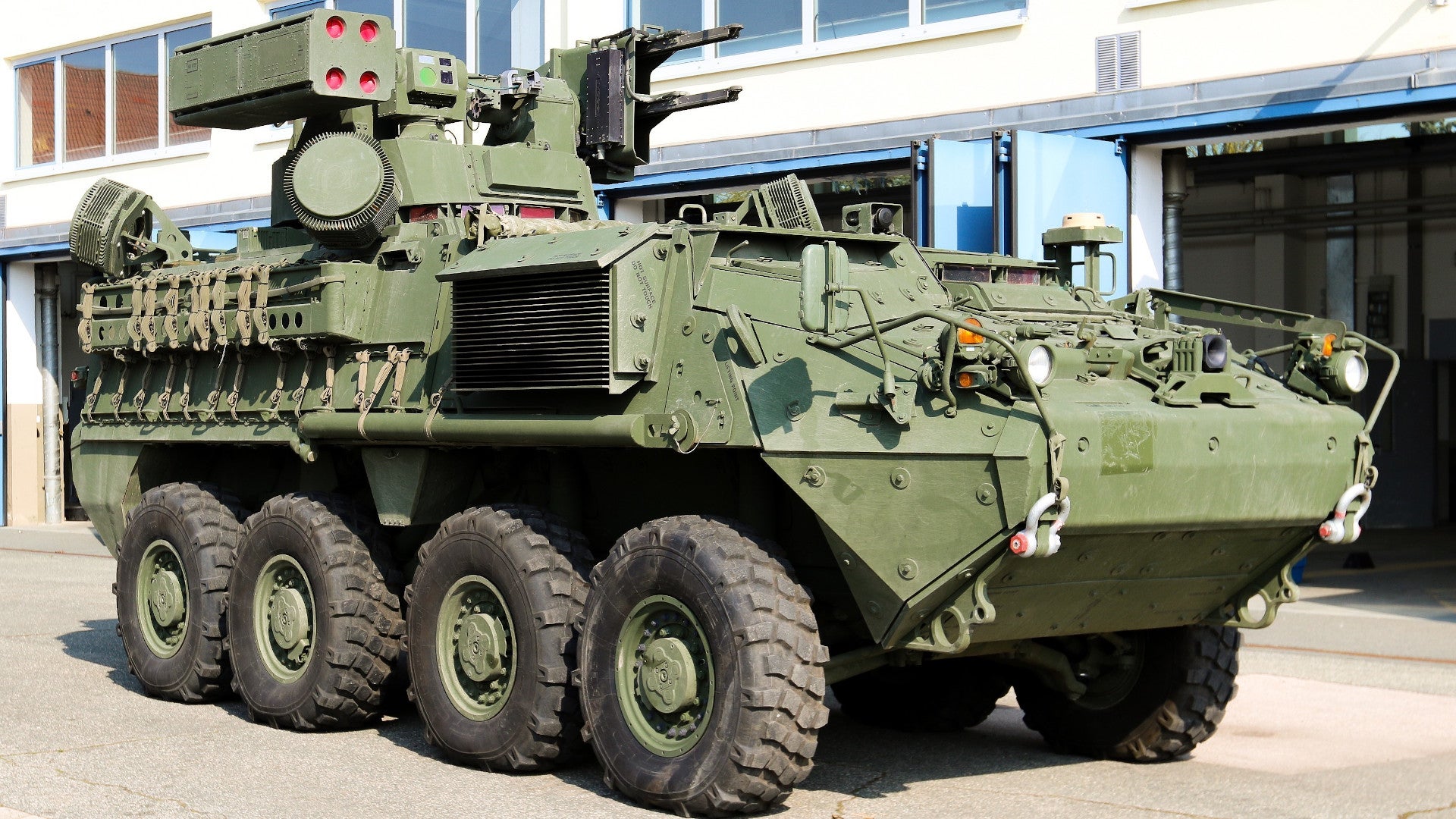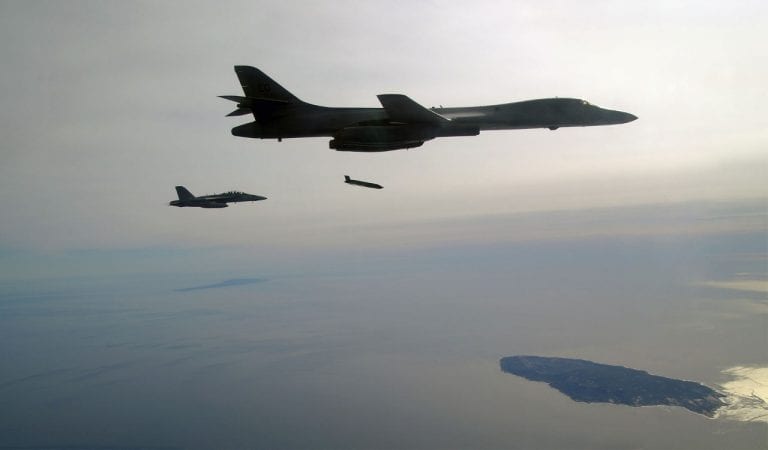The arrival of new Stryker-based air defense vehicles in Germany comes as aerial threats, especially small drones, continue to grow.

www.thedrive.com

The Army Has Started Fielding Its First New Short Range Air Defense System In Decades
The arrival of new Stryker-based air defense vehicles in Germany comes as aerial threats, especially small drones, continue to grow.
BY
JOSEPH TREVITHICK APRIL 24, 2021
The U.S. Army has begun fielding its first new
short-range air defense system in decades as the range of potential aerial threats, from traditional
fixed-wing aircraft and
helicopters to
missiles, and
especially small drones, has grown. The service announced today that a unit forward deployed in Germany recently received the initial batch of operational Mobile Short Range Air Defense, or M-SHORAD, systems, which are based on the 8x8
Stryker wheeled armored vehicle.
The 5th Battalion, 4th Air Defense Artillery Regiment, based at Shipton Kaserne in Ansbach, Germany, now
has a contingent of M-SHORADs alongside its existing
Humvee-based Avenger short-range air defense systems. This battalion, which is assigned to the 10th Army Air and Missile Defense Command (AAMDC), also based in Germany, has already been actively involved in the development and test of this new air defense vehicle, which is the culmination of an Army effort that began in 2018.
Two of the Mobile Short Range Air Defense (M-SHORAD) systems now assigned to the 5th Battalion, 4th Air Defense Artillery Regiment in Germany.
5-4th Air Defense Artillery is actually using some of the prototype vehicles to begin establishing its operational capability. The unit expects to receive a total of 32 M-SHORAD systems by September,
according to Defense News.
"This is truly a testament to our Army's commitment to increase air and missile defense capability and capacity to the joint force, and especially here in Europe," Brigadier General Gregory Brady, head of the 10th AAMDC,
said in a statement. "The 10th AAMDC is proud to be a part of this Team effort and remains engaged, postured and ready to assure, deter, and defend the maneuver force in an increasingly complex Integrated Air and Missile Defense environment, shoulder to shoulder with our NATO Allies."
The Army initiated what was originally referred to as the Initial Maneuver Short Range Air Defense (IM-SHORAD) program in 2018 and subsequently conducted a shoot-off involving a number of contenders. A proposal from Leonardo DRS, the U.S.-based subsidiary of Italian defense contractor Leonardo, based on the Stryker vehicle,
was selected as the winner.
In October 2020, General Dynamics Land Systems, which builds the Stryker series,
received a contract valued at up to approximately $1.2 billion to integrate Leonardo DRS's M-SHORAD system onto an unspecified number of the 8x8 wheeled armored vehicles. An initial award of $230 million would go toward the delivery of 28 systems, which, together with four prototype vehicles, will make up the entire fleet that 5-4th Air Defense Artillery is scheduled to get this year.
The M-SHORAD system consists primarily of a new turret, as well as associated fire control, power generation, and other components, installed on a Stryker. The turret features a four-round
FIM-92 Stinger heat-seeking surface-to-air missile launcher, similar to the ones found on the Avenger system, which you can read
more about here, on one side. On the other side, there are two launch rails for millimeter-wave radar-guided
AGM-114L Longbow Hellfire missiles. The AGM-114L is in U.S. military service today primarily as an air-to-surface and
surface-to-surface weapon, but it has a demonstrated secondary surface-to-air capability against slower-flying threats.
An M-SHORAD system undergoes a test in the United States.
The turret is also equipped with a 30mm
M230 automatic cannon and a 7.62mm
M240 machine gun, which can be used against aerial targets or threats on the ground. Lastly, it features a turreted sensor system with electro-optical and infrared cameras for target acquisition and general situational awareness. In addition, four small fixed-position
RADA active electronically-scanned array(AESA) radars are position on the vehicle's rear detect to help spot and track targets.
When the Army selected Leonardo DRS as the winner of the IM-SHORAD competition,
there were reports that its proposal also included some type of so-called soft-kill system, such as an electronic warfare jammer. RADA's radars
arenotably a component of various
soft-kill counter-drone systems, including the U.S. Marine Corps'
Light Marine Air Defense Integrated System (LMADIS), which is mounted the
Polaris MRZR all-terrain vehicle.
Whether the soft-kill capability has been integrated or not, the M-SHORAD system already represents a significant boost in capability over the Avenger, which has no radar system of its own and is armed only with Stingers and a single .50 caliber M3P machine gun. The Stryker platform offered greatly improved mobility and survivability over the Humvee that Avenger systems are mounted on, as well.
A Humvee-mounted Avenger short-range air defense system fires a Stinger missile during a training exercise.
“There’s really no comparison to anything I’ve operated in my career,” Army Sergeant Andrew Veres, a member of 5-4th Air Defense Artillery said in an official interview. "Everything in these systems is an improvement – the survivability, mobility, dependability, off road ability – it gives us the ability to stay in the fight longer."
The Army is also already looking to complement the M-SHORAD system with a Stryker-mounted
laser directed energy weapon for added defense, especially against small drones, as well as incoming missiles, artillery shells and rockets, and mortar projectiles. Protection against these latter threats is typically referred to collectively as Counter-Rockets, Artillery, and Mortars, or C-RAM. The service is also looking to link together its short and longer-range air and missile defenses into a comprehensive network that also includes various sensors and leverages artificial intelligence and machine learning. You can learn more about that effort, known as the Integrated Battle Command System (IBCS), which promises to revolutionize how the service defends against various aerial threats, in detail
here.
A Stryker wheeled armored vehicle fitted with an experimental laser weapon, painted tan, among other additional systems.
Beyond the M-SHORAD's exact specifications, and the Army's other future air and missile defense plans, these new vehicles that have arrived in Germany a direct reflection of the Army's commitment to reestablish its SHORAD capabilities, which were allowed to wither away after the end of the Cold War as the threat of enemy air and missile attacks appeared to largely evaporate. This turned out to be a very short-sighted decision, as
The War Zone explored in this
past in-depth feature. The prospect of a new major confrontation with Russia after its seizure of
Ukraine's Crimea region in 2014 prompted a resurgence of interest in
various traditional conventional
capabilities with a particular eye toward future conflicts with potential near-peer adversaries. China has since subsumed Russia as the so-called "
pacing threat" in this regard.
In fact, 5-4th Air Defense Artillery, which
was officially activated in its present form in October 2018, was the first dedicated short-range air defense battalion to be stood up in the active component of the Army in nearly 13 years at that point. More than a decade earlier, the service decided that the Army National Guard would become to sole operator of the Avenger system, which had first entered service in 1989.
M6 Linebackers, Stinger-armed SHORAD systems based on the tracked Bradley fighting vehicle that had the Army had fielded first in 1998, had all been converted into standard
M2 Bradley Infantry Fighting Vehicles (IFV) by 2006. The number of issued
shoulder-fired Stingers, a type of weapon also known as Man-Portable Air Defense Systems (MANPADS), was also sharply curtailed
The service also has a smaller number of land-based versions of the ship-mounted
Phalanx Close-In Weapon System (CIWS),
known as Centurions, which it developed together with the U.S. Navy. However, these are niche, low-density assets primarily used to provide C-RAM defense at fixed facilities overseas rather than more general SHORAD.
At the same time, smaller hostile countries,
such as Iran and
North Korea, and
even non-state actors, have increasingly begun to field more capable missile systems. This includes
land-based cruise missiles, against which shorter-range point air defenses could be very useful.
The use of various kinds of armed drones, including
loitering munitions, also known as
suicide drones, is surging, too.
Swarming technology, which
presents additional challenges for air defenders,
is proliferating, as well. Even small modified
commercial quad and hexcopter-type unmanned systems, loaded with
small explosive payloads,
represent a very real threat now and is one that is only likely to grow as time goes on.
This reality has already has prompted the deployment of Army Avengers to places
like Syria and Saudi Arabia. In recent years, the Army has also been developing and fielding
new versions of the Stinger with improved proximity fuzes that are better suited to engaging these kinds of small threats.
“These small- and medium-sized UAS [unmanned aircraft systems] proliferating across the [area of operations] present a new and complex threat to our forces and those of our partners and allies," U.S. Marine Corps General Frank McKenzie, head of U.S. Central Command (CENTCOM), declared to the House Armed Services Committee just this week. “For the first time since the Korean War, we are operating without complete air superiority.”
McKenzie, who took command of CENTCOM in 2019, has
been sounding this alarm for
more than a year now, as have others for far longer,
including The War Zone.
All told, the arrival of M-SHORAD systems in Germany is the start of the fielding of valuable additional air defense capabilities for U.S. forces in Europe, as well as an important step forward in the establishment of new, more capable short-range air defense capabilities across the service after decades of neglect.
Contact the author: [email protected]



